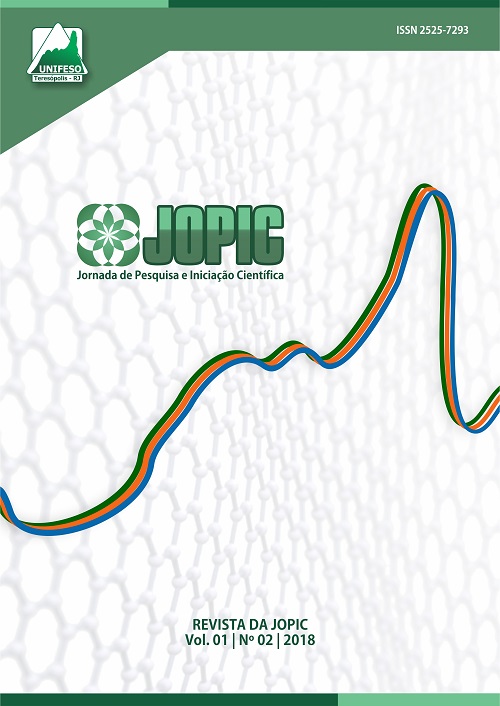EFEITO DA IMAGÉTICA MOTORA CINESTÉSICA CERVICAL SOBRE O CONTROLE POSTURAL
Palavras-chave:
imagética motora cinestésica e controle posturalResumo
Introdução: Imagética motora (IM) é ato de codificar o ensaio mental de uma tarefa pretendida, sem executá-la. Existem evidencias de modulações do controle postural em tarefas do tronco/quadril e tornozelo, entretanto, não existem evidencias com tarefas envolvendo a região da coluna cervical. Objetivo: investigar se a IM cinestésica da região cervical induz a modulações no controle postural ortostático. Materiais e métodos: Os participantes (n=20) foram posicionados sobre a plataforma do Nintendo Wii® e orientados a executar e imaginar três tarefas durante durante 60 segundos: (1) olhos fechados; (2) flexão e (3) inclinação cervical. O número de repetições executadas e imaginadas foram contabilizados e ao final de cada tarefa foi quantificada a vividez de sensação do movimento imaginado. Resultados: foram observados 3 efeitos relevantes: (1) não houve diferença entre o número de repetições executadas e imaginadas, indicando que os participantes de fato imaginaram as tarefas propostas; (2) uma maior modulação do centro de pressão (CP) no eixo ântero-posterior na tarefa de IM cinestésica de inclinação cervical e (3) não houve diferença entre as variáveis do CP no eixo médio-lateral ao comparar todas as tarefas, independentemente do sexo, vividez do movimento imaginado ou das amplitudes do CP e da coluna cervical. Conclusão: Os resultados do presente estudo indicam que tarefas de IM cinestésica cervical induzem a modulações no controle postural ortostático e podem ser utilizadas em práticas clinicas.
Referências
ATHANASIOU, A. et al. Source detection and functional connectivity of the sensorimotor cortex during actual and imaginary limb movement: A preliminary study on the implementation of econnectome in motor imagery protocols. Advances in Human-Computer Interaction, v. 2012, p. 1–10, 2012.
BARTLETT, H. L.; TING, L. H.; BINGHAM, J. T. Accuracy of force and center of pressure measures of the Wii Balance Board. Gait & Posture, v. 39, n. 1, p. 224–228, 2014.
CHAVES, T. C. et al. Confiabilidade da fleximetria e goniometria na avaliação da amplitude de movimento cervical em crianças. Revista Brasileira de Fisioterapia, v. 12, n. 4, p. 283–289, 2008.
CLARK, R. A. et al. Validity and reliability of the Nintendo Wii Balance Board for assessment of standing balance. Gait & Posture, v. 31, n. 3, p. 307–310, 2010.
DECETY, J. Do imagined and executed actions share the same neural substrate? Brain research. Cognitive brain research, v. 3, n. 2, p. 87–93, mar. 1996a.
DECETY, J. The neurophysiological basis of motor imagery. Behavioural brain research, v. 77, n. 1–2, p. 45–52, maio 1996b.
DECETY, J.; JEANNEROD, M. Mentally simulated movements in virtual reality: does Fitt’s law hold in motor imagery? Behavioural brain research, v. 72, n. 1, p. 127–134, 1995.
DECETY, J.; JEANNEROD, M.; PRABLANC, C. The timing of mentally represented actions. Behavioural brain research, v. 34, n. 1–2, p. 35–42, ago. 1989.
DOYLE, R. J. et al. Generalizability of center of pressure measures of quiet standing. Gait & posture, v. 25, n. 2, p. 166–71, 2007.
GRANGEON, M.; GUILLOT, A.; COLLET, C. Postural Control During Visual and Kinesthetic Motor Imagery. Applied psychophysiology and biofeedback, v. 36, n. 1, p. 47–56, 2011.
GUILLOT, A. et al. Functional neuroanatomical networks associated with expertise in motor imagery. NeuroImage, v. 41, n. 4, p. 1471–83, jul. 2008.
GUILLOT, A. et al. Brain activity during visual versus kinesthetic imagery: an fMRI study. Human brain mapping, v. 30, n. 7, p. 2157–72, jul. 2009.
HUURNINK, A. et al. Comparison of a laboratory grade force platform with a Nintendo Wii Balance Board on measurement of postural control in single-leg stance balance tasks. Journal of Biomechanics, v. 46, n. 7, p. 1392–1395, 2013.
JEANNEROD, M. The representing brain: neural correlates of motor intention and imagery. Cambridge University Press, v. 17, n. 2, p. 187–245, 1994.
JEANNEROD, M. Mental imagery in the motor context. Neuropsychologia, v. 33, n. 11, p. 1419–32, 1995.
JEANNEROD, M.; DECETY, J. Mental motor imagery: a window into the representational stages of action. Current opinion in neurobiology, v. 5, n. 6, p. 727–32, 1995.
KWOK, B. C.; CLARK, R. A.; PUA, Y. H. Novel use of the Wii Balance Board to prospectively predict falls in community-dwelling older adults. Clinical Biomechanics, v. 30, n. 5, p. 481–484, 2015.
LEACH, J. M. et al. Validating and calibrating the Nintendo Wii balance board to derive reliable center of pressure measures. Sensors (Basel, Switzerland), v. 14, n. 10, p. 18244–67, 2014.
LEMOS, T. et al. Motor imagery modulation of body sway is task-dependent and relies on imagery ability. Frontiers in human neuroscience, v. 8, p. 1–9, 2014.
LLORENS, R. et al. Posturography using the Wii Balance BoardTM. A feasibility study with healthy adults and adults post-stroke. Gait and Posture, v. 43, p. 228–232, 2016.
MALOUIN, F. et al. The Kinesthetic and Visual Imagery Questionnaire (KVIQ) for assessing motor imagery in persons with physical disabilities: a reliability and construct validity study. Journal of neurologic physical therapy : JNPT, v. 31, n. 1, p. 20–29, 2007.
OKAMOTO, M.; KASAMATSU, S. “Storage Medium Storing a Load Detecting Program and Load Detecting Apparatus.”United States Patent Application Publication, 2009.
RODRIGUES, E. C. et al. Mental stimulation strategy affects postural control. Revista brasileira de psiquiatria (Sao Paulo, Brazil : 1999), v. 25, p. 33–35, 2003.
RODRIGUES, E. C. et al. Kinesthetic motor imagery modulates body sway. Neuroscience, v. 169, n. 2, p. 743–750, 2010.
RUBY, P.; DECETY, J. Effect of subjective perspective taking during simulation of action: a PET investigation of agency. Nature neuroscience, v. 4, n. 5, p. 546–50, 2001.
SIRIGU, A.; DUHAMEL, J. R. Motor and visual imagery as two complementary but neurally dissociable mental processes. Journal of cognitive neuroscience, v. 13, n. 7, p. 910–919, 2001.
Downloads
Publicado
Edição
Seção
Licença
Os textos são de exclusiva responsabilidade de seus autores.
É permitida a reprodução total ou parcial dos artigos da Revista da JOPIC, desde que citada a fonte.
Este trabalho está licenciado sob uma Licença Creative Commons 3.0: http://creativecommons.org/licenses/by/3.0/


